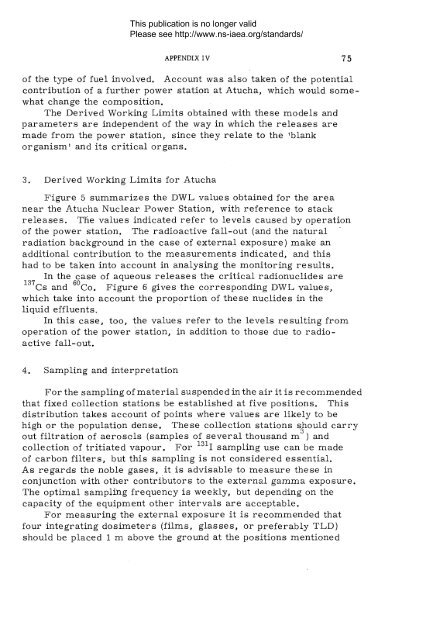Safety_Series_041_1975 - gnssn - International Atomic Energy ...
Safety_Series_041_1975 - gnssn - International Atomic Energy ...
Safety_Series_041_1975 - gnssn - International Atomic Energy ...
Create successful ePaper yourself
Turn your PDF publications into a flip-book with our unique Google optimized e-Paper software.
This publication is no longer valid<br />
Please see http://www.ns-iaea.org/standards/<br />
APPEN D IX IV 75<br />
of the type of fuel involved. Account was also taken of the potential<br />
contribution of a further power station at Atucha, which would somewhat<br />
change the composition.<br />
The Derived Working Limits obtained with these models and<br />
parameters are independent of the way in which the releases are<br />
made from the power station, since they relate to the 'blank<br />
organism' and its critical organs.<br />
3. Derived Working Limits for Atucha<br />
Figure 5 summarizes the DWL values obtained for the area<br />
near the Atucha Nuclear Power Station, with reference to stack<br />
releases. The values indicated refer to levels caused by operation<br />
of the power station. The radioactive fall-out (and the natural<br />
radiation background in the case of external exposure) make an<br />
additional contribution to the measurements indicated, and this<br />
had to be taken into account in analysing the monitoring results.<br />
In the case of aqueous releases the critical radionuclides are<br />
37Cs and 6°Co. Figure 6 gives the corresponding DWL values,<br />
which take into account the proportion of these nuclides in the<br />
liquid effluents.<br />
In this case, too, the values refer to the levels resulting from<br />
operation of the power station, in addition to those due to radioactive<br />
fall-out.<br />
4. Sampling and interpretation<br />
For the sampling of material suspended in the air it is recommended<br />
that fixed collection stations be established at five positions. This<br />
distribution takes account of points where values are likely to be<br />
high or the population dense. These collection stations should carry<br />
out filtration of aerosols (samples of several thousand m ) and<br />
collection of tritiated vapour. For 131I sampling use can be made<br />
of carbon filters, but this sampling is not considered essential.<br />
As regards the noble gases, it is advisable to measure these in<br />
conjunction with other contributors to the external gamma exposure.<br />
The optimal sampling frequency is weekly, but depending on the<br />
capacity of the equipment other intervals are acceptable.<br />
For measuring the external exposure it is recommended that<br />
four integrating dosimeters (films, glasses, or preferably TLD)<br />
should be placed 1 m above the ground at the positions mentioned

















